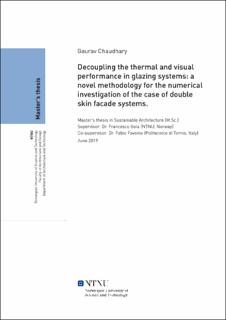| dc.description.abstract | Dynamic transparent envelope technologies such as double skin facades (DSFs) have been used for a long time as an efficient building envelope system aiming to reduce building energy consumption and indoor air quality. Whereas, the true performance of a highly responsive and dynamic system like DSF depends by a great extent also on the control system which controls the various aspects of such a façade system.
A DSF unit with an inbuilt shading system can be operated in various modes with option to control or regulate many components such as the airflow path and airflow rate in the cavity, shading state and slat angles, eventually, the width of air cavity itself in some newer DSFs. Despite the technological evolutions of the components of the DSF and of the DSF systems, operations and control strategies have not evolved much. In reality, although a DSF can have many working modes, only one or two are selected at each time at the design phase for each building and then used. There is a general lack of understanding of how adjustments in different components of a DSF affect the overall performance because of which it has become difficult to utilize their maximum potential. The ultimate goal of this thesis is to show how by considering a more comprehensive use of the DSF enabled by using different control components in a DSF, can be regulated to decouple, i.e. individually control, its thermal and visual performance; and de-facto change the paradigm of how DSF is used and perceived as a building component.
Different configurations of DSFs (with variations in the type of outer/inner skin, gap width and reflectivity of blinds) were used in this study together with benchmark insulated glazing units (IGUs). These façade systems were tested for thermal and visual performance against a set of realistic boundary conditions and all possible variations of operation modes. The DSFs were modelled and simulated in steady-state conditions in EnergyPlus® whereas purpose-built Python® scripts were used to pre-process, post-process and analyses the thousands of simulation cases and output results. The methodology and procedure for all the work are presented in detail which can be used to replicate the work and results achieved in the thesis.
From the analysis of results, it was seen that “Air Supply” and “Air Extract” modes presented a large range of thermal gain when compared to other airflow paths, whereas, higher airflow rate provided the maximum range which reduced with decreasing value of airflow rate. With the mathematical the model used for DSF in this thesis, no significant differences are measured in the thermal gain range of DSFs when air cavity depth was increased to even highest possible realistic value. The results outlined a trend that both range of performance and degree of freedom of decoupling was lowest when the temperature difference (between indoor and outdoor) was zero and the lowest solar radiation. Both these values increased with the increase of the temperature difference on the both sides of 0 with highest being at -45 °C and 20 °C, whereas the degree of freedom of decoupling reduced as incident solar radiation increased.
This work also includes different applications of the methodology proposed in this study. Different ways are proposed for how the results can be used to effectively design a DSF for a given climate, compare the performance of different DSFs and operate a DSF in the most efficient manner. | en_US |
